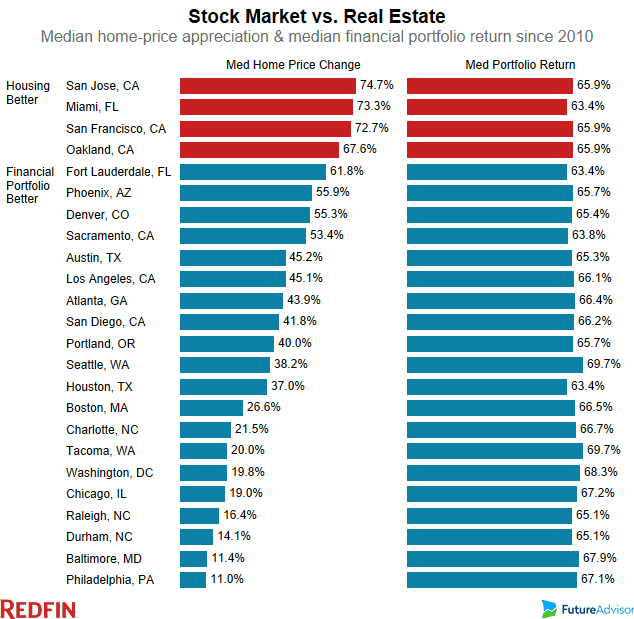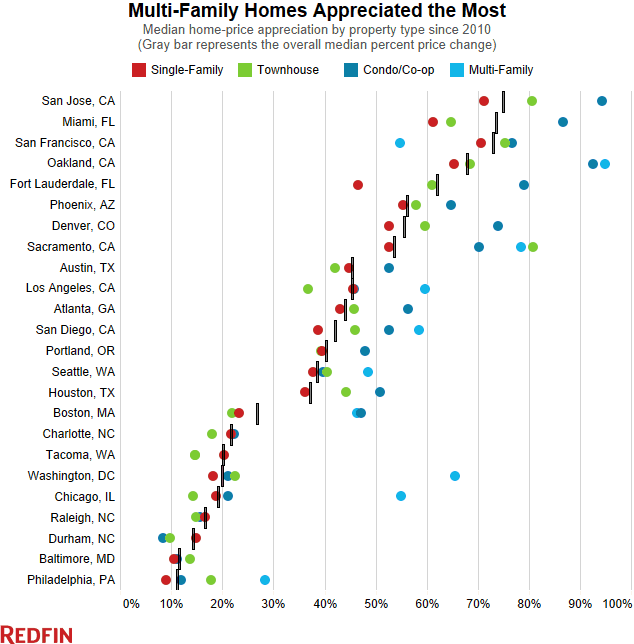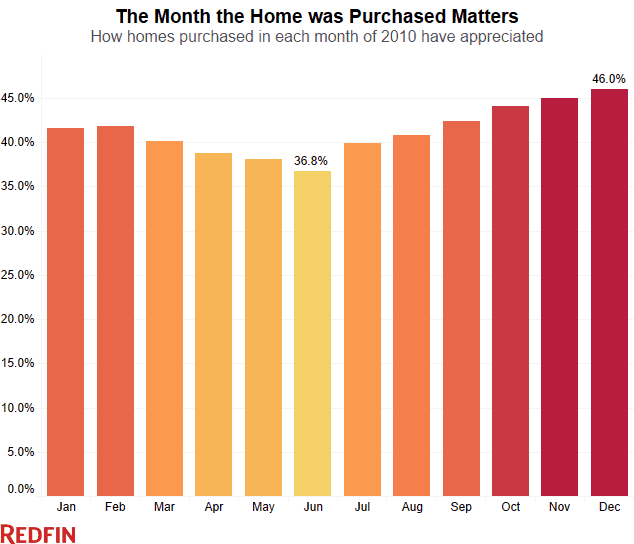Both home prices and financial markets took a big dive during the Great Recession—late 2007 to mid 2009. Since then, we’ve argued that the housing market has led the economy out of the recession, with home prices up in September nationally by 43 percent since January 2010. It seems like we all know one seemingly smart, savvy, or simply lucky person who bought a home right at the bottom of the market and has since sold it for a lot more money or has built up a large amount of equity very quickly. And those of us who didn’t have the same great timing wonder how much our money could have grown had we invested our money similarly. But was a home really the best place to put your money six years ago? Would your savvy homeowner friends have been better off parking their money in a typical stock market portfolio instead?
Redfin partnered with FutureAdvisor, an investment advisory firm, to determine the performance of both the median home purchase and the median financial portfolio since the recession in 24 metro areas. Using data from FutureAdvisor, Redfin calculated the median profit people made on a stock market investment portfolio from January 2010 to May 2016, and compared it with the median housing-price appreciation in each of the metros reviewed.
In 20 out of the 24 metros, the median financial portfolio fetched a higher rate of return than the rate the median home rose in value. Miami (73.3%) and Northern California, including San Jose (74.7%), San Francisco (72.7%), and Oakland (67.6%)—were the exceptions. These places continue to be popular for real estate investors, though Miami and San Francisco have both shown signs of softening lately.

Other metros, such as Philadelphia (11% home price change) and Baltimore (11.4% home price change), have not recovered as strongly, and their residents would have earned more investing in stocks than in the housing market in 2010.
Most variation in the performance of the average financial portfolio has more to do with local age demographics and risk tolerance. For example, stock investors in parts of the Pacific Northwest, such as Tacoma, WA (69.7% portfolio return), fared well through the recovery. Part of this may be explained by there being younger and more risk-tolerant investors working in highly paid tech industries in those areas.
What is striking about this analysis is that from 2010 to 2016, the overall growth has been relatively strong for both real estate and stocks. However, the percentage of Americans who have invested in the stock market this year is near record lows (just 52 percent) since Gallup began tracking this two decades ago. Similarly, homeownership sits at record lows at just over 62 percent, according to the latest Census data.
“There are pros and cons to any investment, but real estate is unique in that it offers the advantage of forced savings through the monthly mortgage payment,” said Redfin chief economist Nela Richardson. “The fact that homeowners build equity just by paying their mortgages every month enforces a savings discipline on consumers that is absent in stocks. For this reason, real estate historically has served as the primary engine of wealth creation, particularly for the middle class.”
Everyone knows that in real estate it’s all about location, location, location—as the above shows. But, as we dug into the data on home-price appreciation for various areas, we discovered two other important factors that affected appreciation: property type and timing.
Similar to how investors choose which sectors to buy company stock in, such as technology or health care, homebuyers must choose what type of property to buy. One main difference, though, is that for financial investments, diversification of stock across sectors helps reduce risk, while maintaining high returns. Yet, without buying multiple homes across the country, a typical homebuyer cannot diversify in this way.
In most metros, multi-family properties, condos and co-ops appreciated the most. Single-family properties appreciated more than condo units in only three metros—Tacoma, Washington, Raleigh, North Carolina and Durham, North Carolina.

With any investment, the “buy low, sell high” mantra emphasizes that timing is everything. While correctly timing the purchase or sale of stocks is difficult to do, timing the purchase of a home is a bit more predictable due to the regular seasonality of competition in the housing market.
Among people who bought a home in 2010, those who bought at the very end of the year, in December, enjoyed the highest home-price appreciation overall at 46 percent since 2010, compared with only 36.8 percent for those who bought in June 2010. This pattern remains true for other years as well. Buying in the winter—when competition is lowest—results in fewer bidding wars and allows you to get a better bargain on the home.

Real estate has been Americans’ number-one choice for long-term investing since 2013, according to a recent Gallup Poll. However, this data should reveal that buying a home for investment purposes may not result in the largest return. So should you sell your home and put everything into the stock market? Probably not. However, people could opt for less expensive homes in favor of more retirement savings. In either case, it is important to remember that past performance for both real estate and financial assets are not indicative of future results.
For this analysis, Redfin used MLS data on over 730,000 property sales during 2010 across 24 metro areas with the best coverage for our data. We measured price appreciation by using the purchase price in 2010 from county records along with the Redfin Estimate in June 2016 for all home sales and took the median for each metro. We controlled for extreme changes in price and required a minimum sample size of 20 listings for measuring appreciation by property type.
FutureAdvisor conducted backtesting of user portfolios as of May 18, 2016 by simulating the percentage return using asset class-based returns from the period January 2010 to May 2016. They then took a median percent return of the financial portfolios for each metro area. Backtested results are calculated by the retroactive application of a portfolio on the basis of historical data and based on assumptions integral to the model which may be subject to losses. Backtested performance is developed with the benefit of hindsight and has inherent limitations. Specifically, backtested results do not reflect actual trading or the effect of material economic and market factors on the decision-making process. Past performance is no guarantee of future results. Read more about FutureAdvisor’s backtesting performance simulations here.


